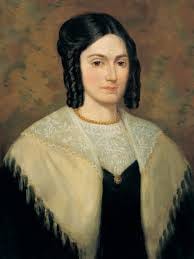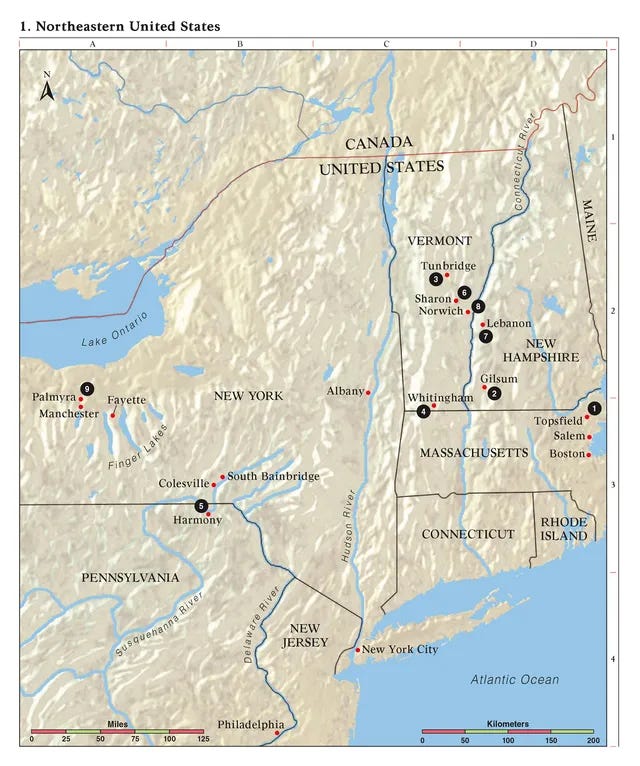Disorderly Preaching
More Historical Background for Understanding Doctrine and Covenants 24
Joseph Smith was given the spirit and power of all the prophets. Joseph Smith’s instruction came directly from the Lord and His messengers. He gathered the faithful around him, but demons and men opposed him, even from his youth, in their futile attempts to thwart the work of Almighty God.
For example, when Emma Smith and several others prepared to be baptized, a mob disrupted the proceedings:
In late June 1830, Emma traveled with Joseph and Oliver to Colesville. Word of Joseph’s miracle that spring had spread throughout the area, and now the Knights and several other families wanted to join the church.
Emma was also ready to be baptized. Like the Knights, she believed in the restored gospel and in her husband’s prophetic call, but she had not yet joined the church.9
After arriving in Colesville, Joseph worked with others to dam a nearby stream so they could hold a baptismal meeting the following day. When morning came, however, they discovered that someone had wrecked the dam overnight to prevent the baptisms from taking place.
Disappointed, they held a Sabbath-day meeting instead, and Oliver preached on baptism and the Holy Ghost. After the sermon, a local minister and some members of his congregation broke up the meeting and tried to drag one of the believers away.
Emma was all too familiar with opposition to Joseph and his message. Some people called him a fraud and accused him of trying to profit off his followers. Others mocked believers, calling them “Mormonites.”10 Wary of trouble, Emma and the others returned to the stream early the next day and repaired the dam. Once the water was deep enough, Oliver waded into the middle of the pool and baptized Emma, Joseph and Polly Knight, and ten others.
During the baptisms, some men stood along the bank, a short distance back, and heckled the believers. Emma and the others tried to ignore them, but when the group headed back to the Knight farm, the men followed, shouting threats at the prophet along the way. At the Knights’ house, Joseph and Oliver wanted to confirm the newly baptized women and men, but the group of hecklers outside swelled to a noisy mob of fifty.
Worried they might be attacked, the believers fled to a neighboring house, hoping to finish the confirmations in peace. But before they could perform the ordinances, a constable arrested Joseph and carried him off to jail for causing an uproar in the community by preaching the Book of Mormon.
Joseph spent the night in custody, unsure if the mob would capture him and carry out their threats. Emma, meanwhile, waited anxiously at her sister’s house while she and their Colesville friends prayed for Joseph’s safe release.11
“Causing an uproar in the community by preaching the Book of Mormon” is one thing that I hope to accomplish through my Substack The Torch. 😊
Emma Smith is one of the most important and interesting figures in the early Restoration of the Church of Jesus Christ and her life merits careful study. She is certainly on of the great witnesses of her husband’s prophetic calling and the truths of the Restoration.
Only four months had elapsed since the Church was organized, and the persecution continued to mount. In some ways, this persecution was a natural result of the disposition of citizens nourished in the social state of American democracy that Alexis de Tocqueville understood and described around the same time that the Church of Jesus Christ arose (see also here):
I have shown in the preceding chapter how the equality of conditions leads men to entertain a sort of instinctive incredulity of the supernatural, and a very lofty and often exaggerated opinion of the human understanding. The men who live at a period of social equality are not therefore easily led to place that intellectual authority to which they bow either beyond or above humanity. They commonly seek for the sources of truth in themselves, or in those who are like themselves. This would be enough to prove that at such periods no new religion could be established, and that all schemes for such a purpose would be not only impious but absurd and irrational. It may be foreseen that a democratic people will not easily give credence to divine missions; that they will turn modern prophets to a ready jest; and they that will seek to discover the chief arbiter of their belief within, and not beyond, the limits of their kind. (Democracy in America II.I.2)
Nevertheless, the Lord’s true Church was re-established through a modern prophet with a Divine mission, the Prophet Joseph Smith. In July 1830, in Harmony, Pennsylvania, the Lord revealed what is now D&C 24 to the Prophet Joseph Smith and Oliver Cowdery. Because of the intense persecution, the leaders of the Church sought safety in partial seclusion, and, as noted in McConkie’s section heading, the Lord gave these three revelations (in D&C 24) to them to strengthen, encourage, and instruct them. The historical note in Lyndon W. Cook’s The Revelations of the Prophet Joseph Smith is also helpful for our study:
On 9 June 1830 the first conference of the Church was convened in the home of Peter Whitmer, Sr., in Fayette, New York. Immediately after the conference the Prophet and others left for Harmony, Pennsylvania. Shortly after arriving home in Harmony, Joseph Smith, Emma, and a few others went to visit the Knights in Colesville, New York, where many believers were baptized. During this visit the Prophet was twice arrested for being “disorderly” in preaching but both times was acquitted. Escaping his enemies in Broome and Chenango counties, the Prophet managed to arrive home in Harmony only to leave to visit the Knights again and confirm some who had been baptized earlier. Upon returning once more to his small farm in Harmony, the Prophet received section 24.
During this period there were only three branches of the Church: Manchester, consisting primarily of the Smith family; Fayette, consisting primarily of the Whitmer family; and Colesville, consisting primarily of the Knight family. (p. 35)
Joseph Smith’s supposed “disorderly” conduct is a model of valiant Christian discipleship, and the revelations contained in D&C 24 are lasting treasures for true followers of Jesus Christ. In the first revelation, Joseph Smith was called to translate, preach, and expound scripture (1–9), in the second revelation, Oliver Cowdery was called to preach the gospel (10–12), and in the third revelation, the laws relative to miracles, cursings, casting off the dust of one’s feet, and going without purse or scrip were revealed. (13–19)
Shortly before this, in April of 1830, Joseph Smith performed what came to be known as the first miracle in the Church (even though many miracles preceded and coincided with the organization of the Church):
After the baptisms in Fayette, Joseph began the hundred-mile trip back to his farm in Harmony. As busy as he was with the new church, he had to plant his fields soon if he wanted a successful fall harvest. His payments to Emma’s father on the farm were already late, and if his crops failed, he would have to find another way to pay off his debt.
On his way home, Joseph stopped at Joseph and Polly Knight’s farm in Colesville, New York. The Knights had long supported him, but they still had not joined the church. Joseph Knight in particular wanted to read the Book of Mormon before he embraced the new faith.4
Joseph stayed a few days in Colesville, preaching to the Knights and their friends. Newel Knight, one of Joseph and Polly’s sons, often talked with the prophet about the gospel. One day, Joseph invited him to pray at a meeting, but Newel said he would rather pray alone in the woods.
The next morning, Newel went to the woods and tried to pray. An uneasy feeling came over him, and it grew worse as he started for home. By the time he reached his house, the feeling was so oppressive that he begged his wife, Sally, to get the prophet.
Joseph hurried to Newel’s side and found family members and neighbors watching fearfully as the young man’s face, arms, and legs contorted wildly. When Newel saw Joseph, he cried, “Cast the devil out!”
Joseph had never tried to rebuke the devil or heal someone before, but he knew Jesus had promised His disciples the power to do so. Acting quickly, he caught Newel by the hand. “In the name of Jesus Christ,” he said, “depart from him.”
As soon as Joseph spoke, the contortions stopped. Newel slumped to the floor, exhausted but unharmed, muttering that he had seen the devil leave his body.
The Knights and their neighbors were astonished by what Joseph had done. Helping them carry Newel to a bed, Joseph told them it was the first miracle performed in the church.
“It was done by God,” he testified, “and by the power of godliness.”5
Nowadays people who wrestle against the adversary like Newell Knight did would be cast into a psychiatric ward and drugged into a chemical stupor instead of helped and healed in the Lord’s way as demonstrated by the Prophet Joseph Smith.
During this same time period Joseph began his translation of Genesis 1:1-5:8, which is now the Pearl of Great Price. (see A Joseph Smith Chronology, p. 16) Newell Knight was soon baptized. In June of 1830, the Reflector published a series of anti-Book of Mormon articles (by Abner Cole) under the satirical title “The Book of Pukei.” (see also here, here, and here)
When Joseph Smith was arrested for disorderly preaching during an evening meeting to confirm new members, James Davidson and John Reid defended him. Josiah Stowell, his former employer, also defended him and testified on his behalf. Joseph was acquitted, arrested again, and acquitted again. In the History of the Church Joseph wrote that in the midst of these trials the Lord comforted the Saints by revealing a “precious morsel” (Moses 1:1-42) (see A Joseph Smith Chronology, p. 17)
On June 30, 1830 Samuel H. Smith embarked upon one of the first missions of the Church to sell the Book of Mormon. Though discouraged, he left a Book of Mormon in the home of John P. Green, Brigham Young’s brother-in-law, and he left another Book of Mormon with Phinehas H. Young, one of Brigham Young’s brothers. (see A Joseph Smith Chronology, p. 17). Thus it was through the valiant efforts of the Prophet’s brother, Samuel H. Smith, that one of the most important, interesting, and controversial figures in Church history, and in American history, was introduced to the Restored Church of Jesus Christ.
Soon thereafter, Joseph received the revelation that we will study more thoroughly in the next post, namely D&C 24.










